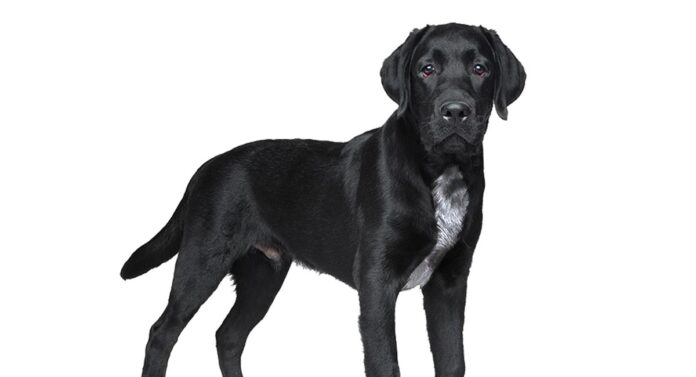A black Lab with a white chest is not necessarily a mixed breed. Purebred Labs can have these markings too. In this article we’ll uncover the genetics behind these white marks and look at where they came from originally. Helping you to decide what your black Lab’s white marks really say about him.
- Why does my black Lab have a white chest?
- Is my dog a purebred Labrador?
- Other possible white markings
- Labrador colors and genetics
- Labrador appearance
- Labrador temperament
Labradors can have white marks on their chest, feet, and tail. This does not mean your Lab isn’t a pure breed. Although it may prevent your pup from registering as a show dog. Do you have a black Lab with a white chest? A white mark on your black Labrador’s chest is not as unusual as you might think. This pattern actually closely resembles the St John’s Water Dog, an ancestor of the modern Labrador breed.
Why Does My Black Lab Have A White Chest?
The Labrador breed coat color is the result of gene interaction, and the presence of certain alleles. We will look into the genetics of coat color in more detail a little later. But let’s take a look now at where these genes could be inherited from.
History of the Lab
Labrador Retrievers have a long history that starts in Newfoundland, Canada. The ancestor of the Lab was a breed called the St John’s Water Dog. Although this breed is now extinct, there are plenty of photos available of the St John’s Water Dog.
This old breed had a thick black coat. In appearance, it is similar to the modern Lab, and the modern Border Collie breed! This is because it had an abundance of white markings amongst its darker fur, predominantly on its chest, face, and feet.

So, these markings were predominant in the Lab’s ancestor. As the breed was being standardized, a black Lab with a white chest wasn’t unusual. In fact, initially, white markings on black Labs were more common than the other fur colors, chocolate and yellow. Until 1892 all Labs were black, but some had white markings.
Is My Dog A Purebred Labrador?
If you have a black Lab with white chest markings, or even markings elsewhere, don’t panic! You might be thinking, does this mean I have a mixed breed? Not necessarily! Mixed breed puppies will inherit random characteristics from either parents. So, if you have a Labrador mixed breed, it’s entirely possible to get a black Lab with a white chest.
But, purebred Labs can have white markings too. Even yellow Labs! White markings on yellow Labs are just a little harder to see. Labradors with these white markings on their fur are often called mismarked Labs. But, because this marking was present in original Labrador ancestors, they are also possible in modern purebred Labs.
Is My Lab Healthy?
If you have a black Lab with white chest markings, you might wonder if there is something wrong with your puppy. Is it healthy? Black and white Lab puppies aren’t going to automatically be unhealthy. They will be just as healthy as any other Labrador puppy! So, don’t panic if your black Lab has white markings. We will look in more depth at Labrador health a little later on.
The only difference between a mismarked, black and white Lab, and a standard colored one is your ability to show them. AKC allows a “small white spot” on a Lab’s chest. But, they state that even this is not “desirable”. This type of Lab, however, doesn’t fall into the ‘mismarked’ category. So, a black Lab with white chest markings may not be right for you if you only want a dog to show it. But, white markings on a working Lab or family companion are absolutely fine.
Other Types of Markings
We’ve been talking about a black Lab with white chest markings so far. But, there are actually lots of other markings that are common on Labs! Let’s take a look at some that you might find on a Lab puppy!
Black and Tan Markings
Some Labs have white markings, but others can have black and tan markings! This is pretty rare. But these puppies can have tan points above their eyes and on their ears and muzzle. Some people think this trait is the result of early cross-breeding with Gordon Setters.
Brindling
Brindling is a distinct pattern where brown fur has flecks of black and red throughout. This pattern doesn’t have to occur all over your dog. Labs with brindling won’t be accepted as AKC show dogs.
Bolo Mark
The Bolo mark refers to a white spot on your Lab’s paw. This mark has a really interesting history! Many people believe that dogs with this mark are descendants of the first dual champion dog, called Banchory Bolo. Even if puppies are born with this mark, it may fade over time. Or become covered in black hairs.
White Ring Around Tail
As well as a white chest on a black Lab, some Labradors can have a white ring on their tail. But, like the Bolo mark, this can also be covered by fur as your puppy grows up.
Mosaic Labrador
A Mosaic Lab will have patches of yellow and black. These are perhaps the most unusual markings!
Labrador Colors
Now we’ve looked at black Labs with white chest markings, and the other markings possible on a Labrador coat. But, we can’t forget the standard three colors. Lab puppies will come in one of the three:
However, there have also been some recent, more controversial colors. These are the silver Lab coat, the charcoal Labrador, and the champagne coat color. They are produced by a dilute gene, which you can read more about in our specific guides.
Lab Coat Genetics
We’ll take a brief look at Labrador color inheritance now, but if you want a more detailed guide, just click here. The black and brown coat colors are controlled by the B allele in your puppy’s DNA. Whereas, the yellow coat color is controlled by the E allele. Pairs of these alleles come from parent dogs to make up the genes that control coat color.
Dominant (B) genes will result in a black Lab. But, two recessive (b) genes will cause a chocolate coat color. These genes can be overridden when a Lab also has two recessive (e) genes, causing a yellow coat. So, getting a black lab with white chest markings will depend on the genes it inherits!
Black Lab with White Chest Appearance
When you get a black and white Lab puppy, you might wonder what else will be different when your dog grows up. But, a black and white Lab puppy will be the same as any other Lab in most elements.
The Labrador breed grows to between 21.5 and 24.5 inches tall as an adult. Generally, they weigh up to 80 pounds. But females are often smaller than males. They are well-proportioned dogs with athletic bodies, as long as they get enough exercise.
Black Lab with White Chest Temperament
Your black and white Lab’s temperament will also be the same as any other Labrador. This breed is friendly, gentle, and athletic. They are known for being easy to train, which makes them great candidates for guide dogs, working dogs, and sporting dogs. They also respond really well to positive, reward-based training. So, training is easy!
Labs are known for being great family dogs, which is why they’re America’s favorite breed. So, you can expect your black Lab with white chest markings to grow into a lovable dog.
Black Lab with White Chest Health and Care
We looked briefly at the health of black and white Lab puppies earlier. But, not at the Labrador breed more generally. Unfortunately there are some health problems that this breed is prone to. The breed has an average lifespan of 12 – 12.5 years. But here are some of the health issues that they can suffer from:
- Hip Dysplasia
- Elbow Dysplasia
- Progressive Retinal Atrophy
- Cataracts
- Obesity
- Cranial Cruciate Ligament Disease
You can reduce the risk of these issues by finding puppies from reputable breeders, going to regular vet check ups, feeding your dog a healthy diet, and giving him enough exercise.
Black Lab with White Chest – Summary
So, what do you think of the black Lab with white chest markings? Have you ever had a Labrador with unusual markings? Make sure to tell us about your experiences with this dog in the comments!
Related Articles
References and Resources
- American Kennel Club
- Templeton, J. ‘Coat Color Genetics in the Labrador Retriever’, The Journal of Hereditary
- Woodhaven Labs, Mismarked Labradors
- Gough A, Thomas A, O’Neill D. ‘Breed Predispositions to Disease In Dogs and Cats’ Wiley Blackwell (2018)
- O’Neill et al. ‘Longevity and Mortality of Dogs Owned In England’ The Veterinary Journal (2013)
The Labrador Site Founder
Pippa Mattinson is the best selling author of The Happy Puppy Handbook, the Labrador Handbook, Choosing The Perfect Puppy, and Total Recall.
She is also the founder of the Gundog Trust and the Dogsnet Online Training Program
Pippa's online training courses were launched in 2019 and you can find the latest course dates on the Dogsnet website



















One of my purebred black Labrador pups has a single white splash in the center of his chest, no other white hairs on him anywhere. If he is bred will he pass this white splash on to his black offspring ?
We adopted a Rescue- 7 month-old jet black lab with a white star on his chest, a tiny white spot on his tail, and another one on his paw. He was 55 lbs. Our vet thought he was mixed with a hound, and wouldn’t get much bigger. He is 11 months now and weighs 80 lbs. He learns new things quickly. He loves people and other dogs. After reading your article I am thinking he may be a true Lab without being mixed. It doesn’t matter to us if he is pure bred. He is a family dog, and we love him so much. Thank you for this article!
I’ve got a female Black Lab with a white chest and white Boots she’s so smart.she thinks she is a human anyone she meets she stands on her hind legs smiles and talks to them..she even laughs at you..I enjoyed reading this article it was very helpful thank you.i would give my last breath for my fur baby..
My husband and I adopted a black lab with a white star on his chest. He weighed 110 pounds when we adopted him and is _______ in height from his feet to his shoulders. Once We met this lab we named him Porter Rockwell after a man we read about in history that provided security for those he believed in. This lab, Porter was to be our security. He barks very little and really believes he is one of the family. He greets all visitors with a smile that will scare anyone with bad intentions off. Porter Knox grandkids down with his tail but places himself in front of the sofa as a step for grandkids to climb on to reach sofa. we have had him almost 5 years and he is the best lab we’ve ever had.
I have a black lab with white markings on her chest and on her hind feet. She was adopted from a shelter. She is a very lovable, sweet dog about 60 pounds. This article was very interesting to me because I thought she might have been mixed with another breed. People have told me that she is a pure lab.
We bred our black lab with a fox red and one puppy has white chest will it. be any different as we have pick of litter and drawer to him do not know what to do help please thanks
I am adopting a black lab with a white chest and toes. I am told she is probably a lab border collie mix. How can I tell if she is a non mix lab but with a white chest.
I adopted 2 black labs a few months ago. One is 4 years and she has thick black hair, white patch on chest and big webbed feet with white toe tips on all four feet. I think she’s a pure bred that looks like her ancestors — St. John’s water dog. She has lab temperament — really sweet, never bites (so far…) soft mouth.
My fox red female lab has white markings on her chest and one back foot. White appears to be more common in fox red as they are predominantly from working lines and the white has not yet been selected out. I find her white markings unique and special to her.
White is hidden in most of the yellows, which your Fox Red actually is. The white is more visible on a chocolate or black Labrador simply because of the contrast. It only takes one parent to have retained the s1 mutation down through the ages since the St. Johns Water Dog for puppies in a litter to express some white hairs.
I have a 6 week old that is black with white feet and chest. how can I tell if he is pureblood